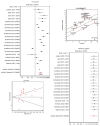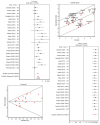Substance Use in the Transgender Population: A Meta-Analysis
- PMID: 35326322
- PMCID: PMC8945921
- DOI: 10.3390/brainsci12030366
Substance Use in the Transgender Population: A Meta-Analysis
Abstract
(1) Background: This meta-analysis aimed to assess the relationship between identifying as transgender and substance use. (2) Methods: We searched for relevant studies in PubMed, Scopus, the Web of Science, and PsycINFO on 21 July 2021. (3) Results: Twenty studies comparing transgender and cisgender people were included in this work, accounting for a total of 2,376,951 participants (18,329 of whom were transgender). These articles included data on current tobacco use, current tobacco use disorder, current alcohol use, current alcohol use disorder, lifetime substance (all) use, current substance use (excluding tobacco and alcohol), current use of specific substances (excluding tobacco and alcohol and including cocaine, amphetamines, methamphetamines, ecstasy, stimulants, heroin, opiates, cannabis, marijuana, LSD, hallucinogens, steroids, inhalants, sedatives, Ritalin or Adderall, diet pills, cold medicine, prescription medications, polysubstance, other club drugs, and other illegal drugs), and current substance use disorder (excluding tobacco and alcohol). We used the ORs and their 95% CIs to state the association between identifying as transgender and those variables. The control reference category used in all cases was cisgender. We employed a random-effects model. Transgender people were more likely to use tobacco (odds ratio (OR) = 1.65; 95% CI [1.37, 1.98]), have used substances throughout their lives (OR = 1.48; 95% CI [1.30, 1.68]), and present current use of specific substances (OR = 1.79; 95% CI [1.54, 2.07]). When current alcohol and substance use in general and tobacco, alcohol, and substance use disorders specifically were considered, the likelihood did not differ from that of cisgender people. (4) Conclusions: The presence of substance use disorders did not differ between transgender and cisgender people. Considering this population as consumers or as addicted may be a prejudice that perpetuates stigma. Nonetheless, transgender people were more likely to use tobacco and other substances, but not alcohol. Hypothetically, this might be an emotional regulation strategy, a maladaptive mechanism for coping with traumatic experiences, or could respond to minority stress, produced by stigma, prejudice, discrimination, and harassment. It is of particular importance to implement policies against discrimination and stigmatisation and to adapt prevention and treatment services so that they are inclusive of the 2SLGBTQIA+ community.
Keywords: addictions; cisgender; gender differences; meta-analysis; substance use; substance use disorders; transgender.
Conflict of interest statement
The authors declare no conflict of interest. The funders had no role in the design of the study; collection, analysis, or interpretation of the data; the writing of the manuscript; nor the decision to publish the results.
Figures






References
-
- Coleman E., Bockting W., Botzer M., Cohen-Kettenis P., DeCuypere G., Feldman J., Fraser L., Green J., Knudson G., Meyer W.J., et al. The World Professional Association for Transgender Health. Standards of Care for the Health of Transsexual, Transgender, and Gender-Nonconforming People. 7th ed, Version 7. Int. J. Transgenderism. 2012;13:165–232. doi: 10.1080/15532739.2011.700873. - DOI
-
- Guzmán-Parra J., Sánchez-Álvarez N., de Diego-Otero Y., Pérez-Costillas L., Esteva de Antonio I., Navais-Barranco M., Castro-Zamudio S., Bergero-Miguel T. Sociodemographic Characteristics and Psychological Adjustment among Transsexuals in Spain. Arch. Sex Behav. 2016;45:587–596. doi: 10.1007/s10508-015-0557-6. - DOI - PubMed
Publication types
Grants and funding
LinkOut - more resources
Full Text Sources

